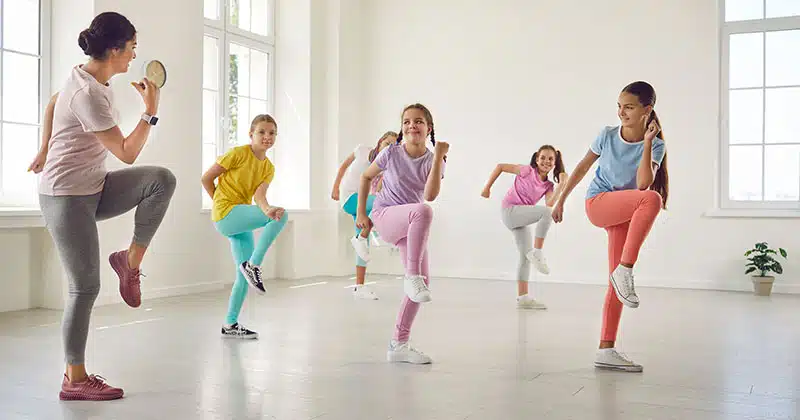Your students will get more out of dance classes if you start with a dance lesson plan.
Here are five types of dance classes. Learn how to build a progressive dance lesson plan in each category. Also, read tips on how to make your classes more inclusive for all students.
Different Types of Dance Class Lesson Plans (with Examples)
Lesson plans for dance classes usually have a thematic core. Let’s explore some of the most common types of dance class themes. These apply across all dance disciplines, from tap to ballet to modern dance.
Technique-centered
This is by far the most common type of dance class. It evolved from classical dance, but you’ll see it used in jazz, hip-hop, modern, and tap too.
Technique may be dictated by a larger curriculum to which you must adhere. Or you may be able to set your own. Either way, work backward from your end goals to create lesson plans that fit together over time to meet those goals.
In a technique-centered dance lesson, students concentrate on improving their existing technique. Often, a new skill is added too, building on the students’ foundation. Typically, you would narrow the focus to one technical area.
For instance, with a ballet class, say you want to work on using plié as a way to achieve better height in jumps. That starts at the barre.
Beyond demi and grand plié, you would work in awareness of bending the knee properly during fondu and développé. You could also add pliés to tendu and battement dégagé or tendu jeté, as well as to frappé.
Carry through those faster pliés into petit allegro work in the center to connect them to jumping. By the time the class is finishing with grand allegro, they’ll really be thinking about bending their knees.
That gives you the opportunity to add in some fun jumps with lots of ballon (air time) that play on that skill. Think tour jeté, barrel turns, or saut de basque.

Choreography-focused
As the name implies, a class focused on choreography is geared around learning and performing preordained steps. You might be preparing for a recital or staged ballet. Or you might simply want to help students work on other skills like:
- Memorization
- Presentation to an audience
- Artistry, drama, and musicality
- Ensemble work (see below)
It’s important to think about how you present new choreography to the class. Some students will be quick learners, while others may struggle to remember long chains of steps.
One way to help the learners who don’t pick up the choreography as quickly is to start at the beginning with the first eight beats or so. Once students master that, add the next phrase. Have the students perform the choreography from the start until it feels comfortable and looks correct.
Then, add the next phrase and repeat. You keep doing this until you reach the end of the choreography.
You may have to take the tempo down a little at first. You can speed up later once students master the movements.
A slower tempo is actually helpful, as you don’t want to dive into complex choreography first without a warm-up. You might want to do a mini barre or floor exercise routine before starting in on choreography.
If possible, have them split into groups and perform for each other, with constructive feedback at the end. You can even use rehearsal costumes like jazz hats in a Broadway class or tutus in a ballet class. This will add to the atmosphere and help them work with props if needed.
RELATED ARTICLE: How to Create Your Dance Recital Program and Quotes to Use
Creative movement
Creative movement classes usually give students the opportunity for a bit more freedom. This class can involve interpretation and even improvisation. It’s a little different from a straight modern class.
One way to encourage dance students to use their imagination is to use prompts. This could be a piece of music they can freestyle to. Or it might be a photograph or a famous painting.
You can ask them first to use words related to the prompt, like “melting” or “warrior.” From there, students can translate those words into specific movements.
This type of class is ideal for the student who finds learning long bits of choreography difficult. They can be more imaginative and free with creative movement.
On the flip side, some dancers are daunted by having to come up with their own choreography. They will need encouragement to open up and use the other side of the brain to break free.
RELATED ARTICLE: Most Popular Dance Studio Music

Partnering and ensemble work
This type of class is essential for more serious students who aspire to a career in dance. It’s also helpful if you have a show coming up to refine a pas de deux or get a large group working together.
For less experienced dancers, ensemble classes are a great way to get them to pay attention to others around them in class. Unison work or performing patterns can be fun for even young kids.
Some potential downsides to this kind of class may include:
- Not having enough partners for lifts and supported work
- Size differences with growing teen partners
- Uneven skill levels between paired students
- Lack of space to accommodate an entire ensemble
Try to find a way to make the lesson inclusive for all. For example, say you’re doing an ensemble hip-hop piece in two rows. Have the front and the back rows switch so everyone gets to be a leader.
It’s tempting to always have the best students in front, but that withholds opportunities from other students. Putting more reticent students in the first row will help them grow their confidence.
Be aware that some disciplines, like ballet, have a history of being more rigid about gender roles. However, some students may not identify as male or female. About 5% of young people in America identify as transgender or nonbinary.
Therefore, avoid making assumptions about pronouns. Some students designated female at birth may want to take on traditional male partner roles and vice versa.
Adopt a flexible and inclusive environment where everyone can be who they are.
RELATED ARTICLE: How Dance Studio Software Is Changing to Reflect Society’s Growing Inclusion
Building strength and flexibility
Sometimes, you want to take a break from the typical class progression and incorporate more of a training approach. A strength or flexibility class can make students better dancers and help with injury prevention.
It’s a nice change if students have been working extra hard on technique or choreography. They can then take the exercises with them to do at home.
Some common themes for this type of class include:
- Building core strength with Pilates
- Working on balance (on or off a balance board)
- Using elastic bands to increase lower limb strength
- Barre and floor stretches to improve range of motion
Don’t forget to use some pleasant background music. Encourage students to use the mirrors to self-correct form. You can also pair students together to help each other with flexibility exercises.
When working on stretching, make sure students are thoroughly warmed up first.
Does it feel like too much to make an entire class around strength or flexibility? If you’re teaching children, their parents may expect them to be doing a more traditional class for their hour. You could stop class early once a week to do 15 minutes of this work and still see great benefits.

Creating a Dance Class Lesson Plan
As mentioned previously, students progress at different levels. And with dance, there are also natural abilities and athleticism to consider. So, you want to be sure to structure your lessons to appeal to everyone.
First, make sure your students are clear about what you’re asking for. Don’t move on to more advanced material until everyone is comfortable with the existing curriculum.
You can split the class into groups if there is a wide range of skills. They don’t necessarily need to do the same technique or choreography. Consider giving them each their own variations based on what they can do. This is similar to how adult yoga classes offer modified poses for novices or those with less flexibility.
Try to make warm-ups and cooldowns fun and not too taxing. That way, everyone starts and ends the class on a positive note.
If you use the same ritual warm-up and cooldown in every class, students can commit it to memory. Then, they can focus on getting more from the movements rather than scrambling to keep up.
You could also reserve a few minutes at the end for questions, especially with adult beginners.
Adapting the Lesson Plan
Earlier, you read about making your classes more gender inclusive. You may also have students with physical or intellectual disabilities in class. It’s essential to make them feel welcome and included too.
You don’t have to single them out or make them feel self-conscious, but you may need to adapt some elements for them. Of course, there should be a policy of no teasing, bullying, or making any students feel uncomfortable.
You can be matter-of-fact about having dance students of all abilities work together. For example, there are professional dance companies today that incorporate people in wheelchairs.
These dance companies also work in their local communities to integrate people of all abilities in dance. Their goals include:
- Encouraging inclusiveness
- Growing self-confidence
- Increasing physical expression
- Respecting everyone’s physical space
- Working together as a group
- Having fun and learning to love dance
Make it your practice to have everyone shoot for these goals, regardless of their abilities. That’s what dance is all about!
RELATED ARTICLE: The Importance of Fostering Inclusion in Your Dance Studio — Why It Matters


